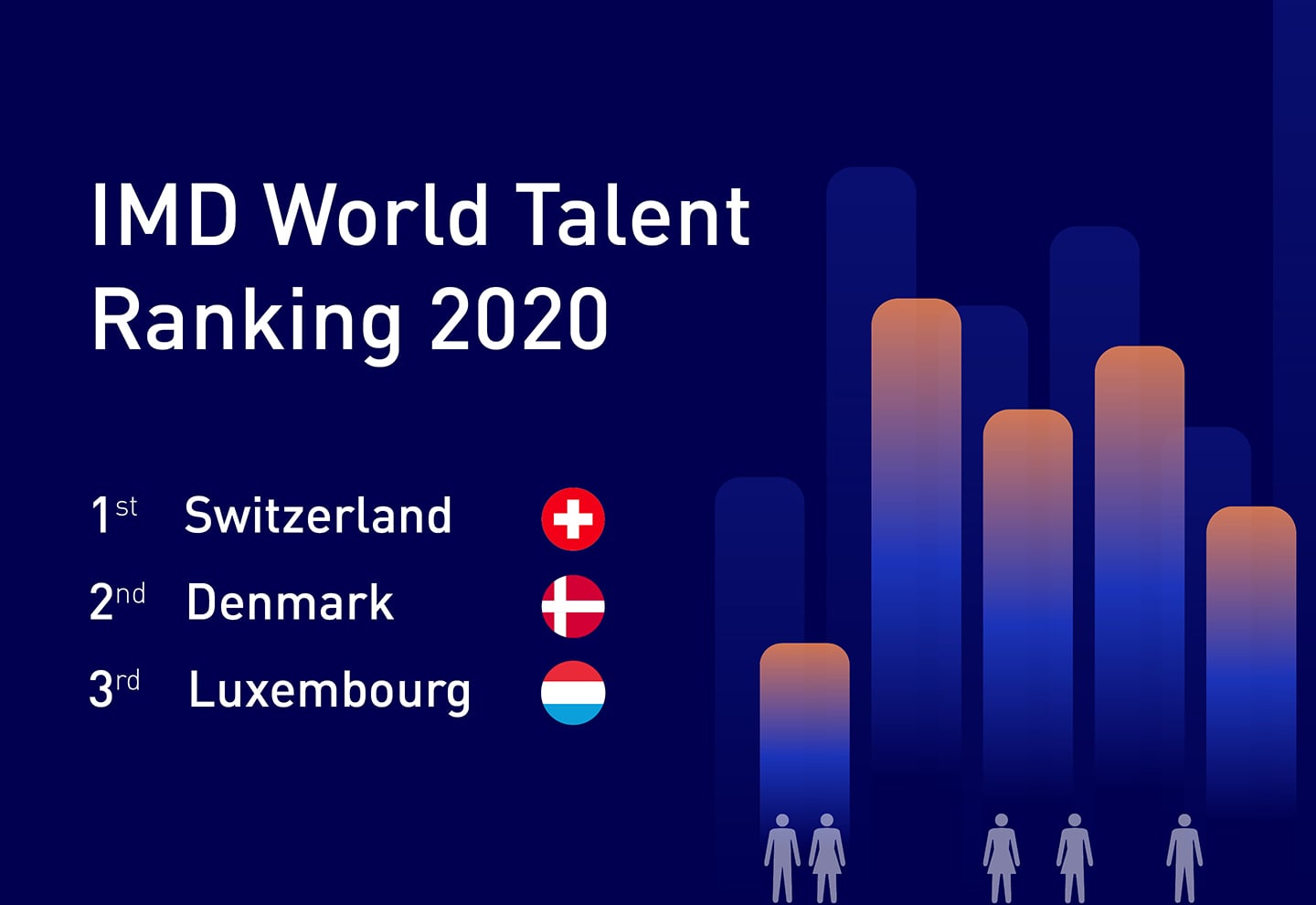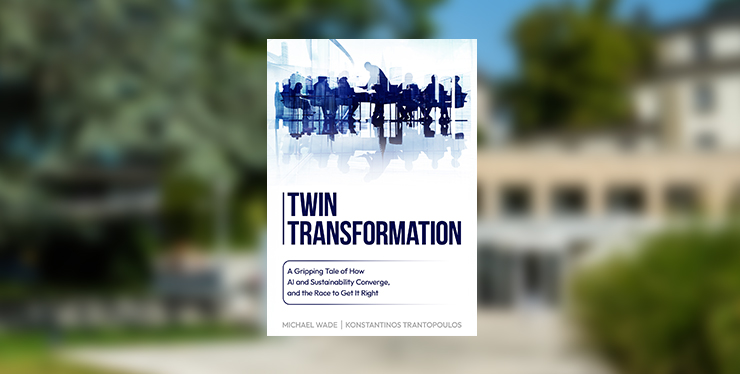
What drives an economy to be highly talent competitive?
In this edition of the IMD World Competitiveness Center’s Criterion of the Month, we outline three important insights:
- Talent competitive countries focus their talent development efforts in a holistic manner, balancing between academic rigor and vocational training to enhance the skills and competences needed.
- Their enterprises invest in keeping the workforce motivated — fundamental for sustaining productivity and thus for a smoother transition to a post-COVID-19 environment.
- They are economies that are open to the movement of people and ideas.
The IMD World Competitiveness Center’s World Talent Ranking assesses the extent to which economies are able to develop, attract and retain talent for enterprises operating in those economies.
To do so, the ranking evaluates three factors: how an economy fosters the domestic talent (‘investment and development’); the extent to which an economy retains homegrown talent and also draws from the international talent pool (‘appeal’); and the quality of the skills and competences that are available in the economy (‘readiness’).
In 2020, Switzerland and Denmark hold the first and second positions, respectively, for the sixth consecutive year. Luxembourg, Iceland and Sweden complete the five most competitive economies with respect to talent. Austria, Norway, Singapore and the Netherlands remain in the top ten positions with small fluctuations from last year while Canada moves five spots to become the eighth most talent competitive economy.
Figure 1 provides the list of the 15 highest-ranked economies in the 2020 ranking.
Figure 1. The 15 top performers in the 2020 IMD World Talent Ranking
Click here to see the full list of the 63 economies
Three areas are common to all economies that performed strongly in this year’s ranking. They concern (a) education, (b) the pandemic and (c) international talent.
An education system that has all bases covered
First, highly competitive countries focus their talent development efforts on every stage of the educational process. We can be sure of this because each year we measure criteria that capture the quality of education at all levels: primary, secondary and tertiary.
Furthermore, and still education-related, in the most competitive economies, mid- and high-level executives believe that apprenticeships are “sufficiently implemented” and the provision of employee training is a priority for companies.
Table 1 shows five areas we measure that encompass both academic and more vocational aspects.
In all these indicators, the best performers are countries that top the overall talent competitiveness rankings. What do we notice across the board?
- Governments, in addition to the funds allocated for education, are also building institutional frameworks for strong infrastructure, to facilitate apprenticeships and employee training.
- Executives perceive that universities and business schools “align their curricula to the needs of their economies”.
- Enterprises are contributing to the lifelong learning and reskilling of the labor force by prioritizing the need for employee training.
Table 1: Top- and under-performers in criteria related to education
Motivating the workforce pays off
The second trend in this year’s results is an indication of how the pandemic affected our lives in different ways. The loss of the workplace and the birth of a ‘place from where people work’ has been disruptive for many, not least because of the suddenness with which it occurred.
Throughout the world, those members of the labor force whose tasks can be accomplished remotely are working from home. There are different pros and cons for this reality.
However, as has been pointed out by different researchers, resilient enterprises are those that manage to balance performance KPIs with the motivation of their labor force. The latter is an important component in the sustainability of workers’ efforts when away from both the physical workplace and their co-workers.
The last row of Table 1 captures this trend: in the midst of the current crisis, economies that top the talent ranking are also those that executives perceive to have managed to keep the workforce continuously motivated.
Remaining attractive to the outside world
The final aspect that this year’s talent heavyweights have in common will come as no surprise: they appeal to an international talent pool. These countries are all open — both to the movement of people and ideas.
Figure 2 captures the relationship between the attitudes that society has towards globalization and the aforementioned appeal factor. It shows that despite its current somewhat restrictive immigration practices, the USA remains open and attractive to overseas talent and can retain the local component of the talent pool.
Figure 2: Relationship between openness and the ‘appeal’ factor (how well an economy retains homegrown talent and draws from the international talent pool) in the 2020 ranking
Other talent-competitive countries such as Switzerland, Luxembourg, Germany, Austria and Norway also show positive attitudes towards globalization and strong ‘appeal’.
As we edge closer to finding a vaccine, we should anticipate further disruption to the way we work and the relationship between our home space and our working environment.
Irrespective of the outcome, balancing academic rigor and vocational training to enhance skills and competences needed, keeping the workforce motivated and promoting frameworks that support the movement of people and ideas will remain necessary to the build domestic and international pools of talent of the future.
Research Information & Knowledge Hub for additional information on IMD publications
IMD produces a yearly Smart City Index offering a balanced focus on economic and technological aspects of smart cities on the one hand, and “humane dimensions” of smart cities (quality of life, environment, and inclusiveness) on the other. In this...

The European Commission is once again focused on boosting Europe’s competitiveness, this time by integrating the bloc’s capital markets. The EU executive published a range of measures on March 19, aimed at unlocking the €11.6 trillion ($12.8 trill...
We extend the mixed gamble perspective to explain how family-controlled firms frame and evaluate the difficult trade-off between potential gains and losses in financial wealth (FW) and socioemotional wealth (SEW) when pursuing portfolio-level stra...
Foreign firm access to the public procurement markets—valued at some $13 trillion worldwide—is not governed by standard trade policies and multilateral trade accords. In trade policy circles, failure to publish procurement tenders in a global lang...
Research Information & Knowledge Hub for additional information on IMD publications
Published by International Institute for Management Development ©2025
Research Information & Knowledge Hub for additional information on IMD publications
in I by IMD
Research Information & Knowledge Hub for additional information on IMD publications
Research Information & Knowledge Hub for additional information on IMD publications
IMD World Competitiveness Center Report, 8 April 2025
Research Information & Knowledge Hub for additional information on IMD publications
Research Information & Knowledge Hub for additional information on IMD publications
in Journal of Management Studies 20 March 2025, ePub before print, https://doi.org/10.1111/joms.13218
Research Information & Knowledge Hub for additional information on IMD publications
Research Information & Knowledge Hub for additional information on IMD publications
Research Information & Knowledge Hub for additional information on IMD publications
in The Quarterly Review of Economics and Finance January 2025, vol. 99, 101898, https://doi.org/10.1016/j.qref.2024.101898
Research Information & Knowledge Hub for additional information on IMD publications







